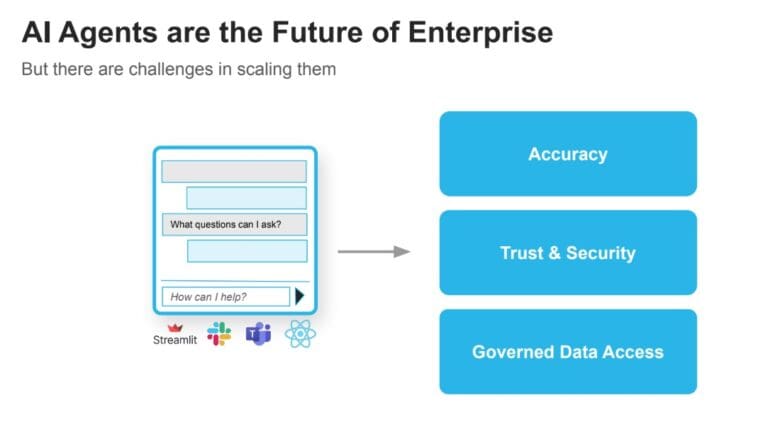Data engineering plays a major role in the AI era. Yet, it remains a difficult discipline due to high staff shortages and expectations. Efficiency and automation are therefore becoming increasingly important. With agentic AI, a new wind blows in the tech world to perform certain tasks. Snowflake, therefore, sees opportunities to take a new step through Cortex Agents.
Cortex has become one of Snowflake’s main assets in about a year and a half. At the time, it appeared as a managed service that allows companies to build AI applications and analyze data more easily. To do so, Cortex offers the ability to add large language models (LLMs), task-specific models, and vector search to software. Now, a range of capabilities is being added by allowing agents to play a larger role within the Snowflake AI Data Cloud.
In short, the agents promise to simplify complex data tasks and increase productivity. That applies to data engineers, as well as employees within other departments. “They’ll enhance the productivity for many teams such as customer support analytics, engineering, and they’ll free up employee time to focus on higher value things,” said Snowflake-Head of AI Baris Gultekin. But what precisely does it do, and how can companies take advantage of it?
Tip: Snowflake lowers the barrier for building AI apps
What is it?
Gultekin describes the new capabilities as a specialized form of AI agents called data agents. Agents can perform a fixed list of tasks independently, that is, without human intervention. Snowflake uses that to automate a series of tasks related to gaining accurate insights by selecting the right data sources. The data agents, therefore, handle processes for retrieving and analyzing data while staying within the rules and configurations for connecting to enterprise data.
The new agents use two core components: Cortex Analyst for structured data and Cortex Search for unstructured data. Cortex Analyst converts natural language into SQL queries, executes them and turns them into responses. This, with an accuracy of more than 90 per cent, Snowflake claims based on internal benchmarks. It can also handle complex multi-table environments. On the other hand, Cortex Search allows data from text, audio, video and images to be searched. This is done via vector and lexical (keyword) search, with semantic rearrangement on top. This allows rapid retrieval of high-quality data.
The four core tasks
By relying on the above technology, Snowflake can use Cortex Agents to perform four core tasks of a data workflow. Among these is scheduling. People often switch between applications to process data from structured and unstructured sources. Through Cortex Agents, it is possible to integrate with any application by relying on a REST API. Suppose a business user first requests top distributors based on revenue (structured data) and then a contract (unstructured data). Cortex Agents can handle that request and create a plan. Several scenarios are possible: explore options, split into subtasks and select a tool.
Once the plan is in place, the data agent can retrieve data. This is where the interplay of Cortex Search and Cortex Analyst comes in handy by being able to handle both types of data. Snowflake collaborates with a wide range of tools to ensure that the right enterprise data is used.
The next step is best described as the reflection phase. After using a tool, the agent evaluates the results to determine the next steps. Consider asking for clarification or generating a final response. Orchestration allows complex data commands to be handled while compliance guidelines remain followed.
Finally, there is the monitoring phase. Users can measure statistics, analyze performance, and adjust behavior to improve further. Application developers can use the TruLens tool in this phase to monitor agent interaction. Snowflake expects continuous monitoring and refining control to increase trust in data agents. Companies can then scale the capabilities further with confidence.
Special role for Claude 3.5 Sonnet
Snowflake thus relies heavily on existing Cortex options when introducing agents but also comes up with new Cortex features here and there. However, an important part that we cannot leave unsaid is its collaboration with Anthropic. The Claude 3.5 Sonnet model runs within the Snowflake platform for reasoning, coding and executing complex workflows. Claude 3.5 Sonnet now powers Cortex Analyst and can be used in Cortex Agents. By being supported by Claude 3.5 Sonnet, Cortex Agents should be able to plan, orchestrate, reflect and monitor AI tasks more precisely. Anthropic’s multimodal option allows it to extract insights from more unstructured data, including images. Snowflake assures that all interactions happen within the AI Data Cloud.
Anthropic Chief Product Officer Mike Krieger says this renewed partnership stems from a shared vision of secure and responsible AI deployment. “For the exact kind of enterprises that both we and Snowflake are talking to, having a model that has the right safeguards in place is hard to jailbreak, has been trained responsibly, is actually a net plus,” Krieger said.
Cortex Agents is now available as a public preview.
